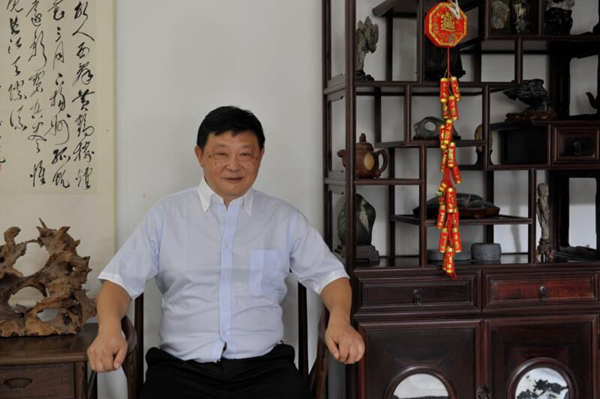The ancient meaning of spring and autumn is transcendent and natural
Time 2019-11-12
Xiao Han is a quiet and introverted person. He is not good at speech. His calligraphy, like himself, looks weak, soft, but powerful and ancient.
In more than 60 years, social changes have a profound impact on Xiao Han's life trajectory, and also experience his mind. He is indifferent to fame and wealth, not to publicity. To this day, what he really pursues is calligraphy. He has been obsessed with calligraphy for decades, which is enough to comfort his soul. Because of the convenience of his family, he was able to learn calligraphy with Zhang Kaifan, the former chairman of Anhui CPPCC, and was guided by his demonstration for a long time. Zhang Kaifan's calligraphy has been praised by Chairman Mao Zedong, and he can be called the most influential calligrapher in the early years of Anhui calligraphy. He learned from the subtleties of Zhang Kaifan's cursive script. Sometimes he was bold and unrestrained, sometimes he was gentle and nimble, which showed his skill.
After living abroad for many years, it was difficult to buy a bottle of ink. In addition to the busy business, his pursuit of calligraphy was temporarily put on hold. When he returned to his motherland, his deep love burst out again, and he began to focus on studying Zhang's Wei tablet and Wang Xizhi's preface to the holy religion. After that, he transferred to Yu Youren, whose contribution to Chinese calligraphy is to open up Wei stele and cursive script, and to create a new realm of calligraphy Stele Study. Xiao Han got the best of his calligraphy integration and explored very quickly.
Techniques should not be considered by calligraphers. Xiao Han pursued Wei and Jin Dynasties, studied hard and looked forward to ancient sages. In addition, he saw a large number of Ming and Qing calligraphy and painting in his early years, as well as his own rich knowledge and cultivation, his ability to appreciate calligraphy and painting is particularly outstanding. The appreciation of calligraphy and painting requires rich professional knowledge and a high vision, and he is not able to cultivate in one day. For decades, the appreciation of calligraphy and painting, his pursuit of calligraphy, and the improvement of his calligraphy accomplishments have promoted and complemented each other.
Throughout the ages, calligraphy creation is the natural flow of Calligrapher's mind. Xiao Han's quiet heart and humanistic feelings reflect each other. When he was young, he spent that period of extraordinary years peacefully. He traveled abroad in middle age. In his old age, he had read all kinds of life styles. His writing was dry, wet, thick and thin. He deconstructed the words one by one, just like chewing life. His fame and benefits were beyond the natural things. Nowadays, ugly books and strange books are popular in the Chinese calligraphy circle. The root of it is the instability of mind, or the delusion of easily surpassing the ancients, or the exaggeration of the strokes to cheat the local tyrants. Xiao Han totally refused, not involved in it, he wrote from no intentional affectation, all of which are natural expressions of his temperament. His writing style is elegant, the center shinbone, strong and soft, sparse and rhymed. Watching his calligraphy, such as reading a Confucian's story of years, spreading orderly, like a cloud rolling cloud Shu, naturally formed.
Today, Xiao Hanzhi's calligraphy charm is transcendent and quite ancient.
Now Xiao Han is mainly engaged in running grass and occasionally in Tang Kai. I believe that in time, he will have something to gain and appear on the broad art stage in an ancient and detached manner. (by Han Hongfei, curator of calligraphy and painting, best-selling writer)
A period of nostalgia and remembrance
In the early years, it was vaguely known that Xiao Han was learning Chinese characters with Kailao (the former chairman of Anhui CPPCC, Uncle Zhang Kaifan). It was a time when he did not pursue traditional culture, and no one thought that there was anything special about learning Chinese characters with Kailao. I don't care what Scripture he got from Kailao and what kind of book inheritance he got. What's more puzzling to our friends in the same age and familiar life circle is that they have never seen his performance in calligraphy, or even his calligraphy works, even in the calligraphy activities commemorating Kailao. This can only leave us a similar space. As Kailao's disciple, he probably has lost his reputation. Xiao Han's calligraphy works spread in the circle of friends in recent years, and then became home ornaments of friends. Soon, they frequently went in and out of calligraphy exchange activities and appeared in the newspapers. Xiao Han's calligraphy works are well known for their cursive script. They have a relatively regular cursive script inheritance. They draw on Kailao's free and unrestrained style, and also follow Shutong's regular cursive script style. His employment can be seen in the stippling. Especially in the details of the processing reflects a good flexibility and many years of writing and ink skills. He remembers Kailao's words: "learn words with me and write the same words with me at the end of learning. Then you are a failed student." Over the years, we have been seeking innovation and change, absorbing and learning from all sides, and taking our own path of calligraphy study. Has it formed its own unique style? I asked him more than once; he said that now he could only say that he was still in the process of pursuing. As for his works, he didn't dare to talk about them. Instead, he talked about his experience of learning calligraphy with Kailao. His interest and gratitude were overwhelming.


